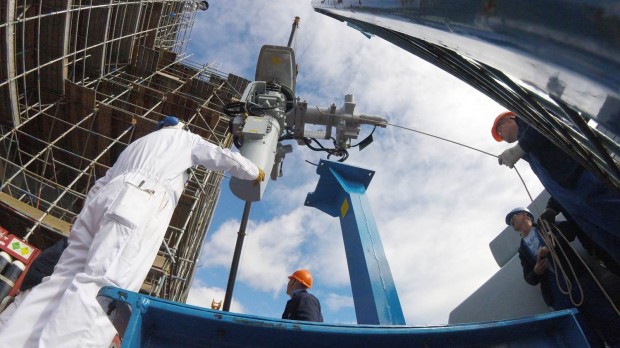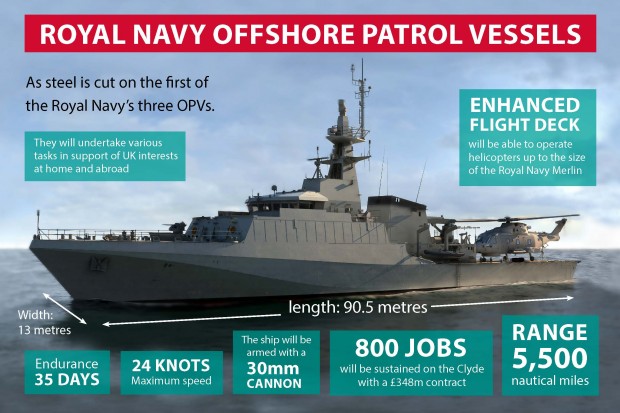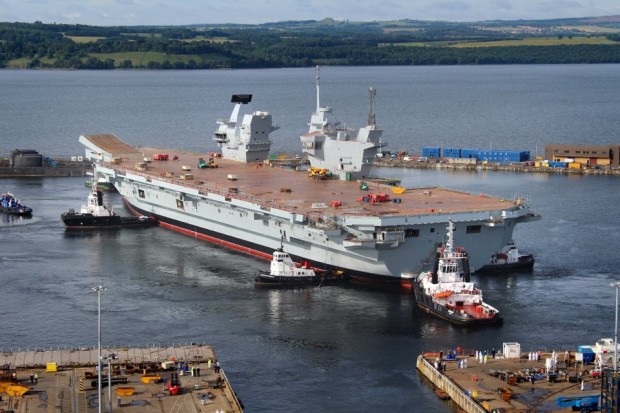
I was recently in Govan to cut steel for HMS Trent, the third Offshore Patrol Vessel (OPV), to be built for the Royal Navy by British shipbuilders in Scotland.
These ships will provide an important capability, performing vital tasks in defending the nation’s interests around the world. Work on the patrol vessels will sustain 800 quality engineering jobs in Scotland ensuring that the shipyards on the Clyde remain at the heart of a thriving shipbuilding industry.
This is the latest in a long list of investment under this government, which will not only deliver a world class capability to our world class Navy, but also vital investment for our shipyards and naval bases sustaining employment across the UK.
The OPVs will pave the way for the next generation of frigates, the Type 26 Global Combat Ships, which will become the workhorses of the fleet. Already we can see examples of cutting edge technology that these ships will deploy. The 3D Artisan radar has just been fitted to the aircraft carrier HMS Queen Elizabeth in Rosyth marking another major milestone in the ship’s preparation for sea trials next year.
The radar can simultaneously track more than 800 objects offering supreme accuracy and is already proving its worth to deliver uncompromising air defence to the Type T23 frigates and will be cross-decked onto their T26 successors. This is part of a package of around £990 million worth of investment in the T23s including upgraded weapon and power and propulsion systems which will maintain their position as the backbone of the fleet while helping to de-risk the future transition into service of the Type 26 class.

While HMS Queen Elizabeth continues her steady progress towards operations, her sister ship, HMS Prince of Wales is also rapidly taking shape. We have recently achieved another milestone as ‘Lower Block 4’, the largest hull section of the ship, weighing 11,200 tonnes and constructed in Govan was “skidded” into place, i.e. aligned and assembled with the awaiting forward sections of the ship in the Rosyth shipyard. This means around 30,000 tonnes of the superstructure is in place. So far, over £3 billion has been invested in the Queen Elizabeth Class work in Scottish yards, supporting some 4,000 jobs and hundreds of apprentices at both Rosyth and the Clyde.
The video above shows a time-lapse of the forward 26,500 tonnes of HMS Prince of Wales is skidded back with millimetre precision to the 11,200 tonne section of the rear of the carrier in Rosyth, Scotland. The second future flagship of the Royal Navy is being built across the UK by the Aircraft Carrier Alliance.
Together with our fifth generation fighter aircraft the F35B Lightning II, currently undergoing trials in the US, it is already clear that these 65,000 tonne symbols of British industry and innovation will be at the forefront of our nation’s maritime capability deploying across every ocean in the world for decades to come.
Defence investment is also evident below the waves. In August, HMS Artful, the third of seven of the Navy’s Astute Class hunter killer submarines was put to sea for the first time - a result of £1 billion investment in leading edge British technology, submarine building and know how. We also recently awarded a £270 million contract to upgrade the Spearfish heavyweight torpedo. The Astute Class boats are the largest and most advanced attack submarines to be ordered by the Ministry of Defence; providing unprecedented levels of stealth and attack capability for the Royal Navy.
Artful now commences trials from her new baseport in HM Naval Base Clyde at Faslane, which is set to become the home to all Royal Navy submarines, and the submarine centre of specialisation by the end of this decade, bringing jobs and investment to Scotland. The Chancellor recently announced £500 million of funding for the submarine base, securing 6,700 jobs and creating thousands more. Meanwhile work continues around the Successor strategic deterrent programme – the like-for-like replacement for each of the four Vanguard class submarines.
None of this is possible without an equal investment and recognition of the people involved. Whether that be the highly skilled engineers working across industry or the Royal Navy personnel charged with bringing the capability to life in shipyards and naval bases across the country or delivering on operations around the globe.
This long list of next generation capability, combined with other existing naval systems, forms an efficient, carefully designed and credible whole. This is all the more striking when taking into account the substantial investment to strengthen our UK maritime defence industrial base including a ship building strategy with Scottish shipyards at its core but with a resonance that extends across the UK. This means the Royal Navy is being equipped with world class ships and is set to become the most modern Navy in the world, assuring a better and more secure future for Britain.
Follow us on Twitter and don’t forget to sign up for email alerts.



